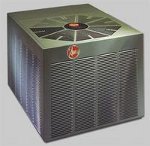Heap Pumps: Keeping Your Home Warm
Author: steve Published Under: Home
If you have ever spent a winter in a home with no heat or a heat pump that is too small for the square footage of the house, then you can appreciate how important having a fully working heating system can be. There are a few options for heating systems, with the most efficient types of systems usually costing a great deal more upfront to install, while saving a great deal on operating costs.
The Traditional Heat Pump
 Heat pumps are one of the most common types of heating units and in a relatively moderate climate, tend to be fairly efficient. Heat pumps work by circulating a highly compressed liquid and transferring the heat generated by this process to coils, with a fan blowing on the coils to send the heat into the house.
Heat pumps are one of the most common types of heating units and in a relatively moderate climate, tend to be fairly efficient. Heat pumps work by circulating a highly compressed liquid and transferring the heat generated by this process to coils, with a fan blowing on the coils to send the heat into the house.
However, in colder climates, heat pumps are not as effective, as once the temperature drops below freezing, the single compressor is no longer sufficient to supply heat to the house. So, at this point, an auxiliary heater will kick in and run in unison with the heat pump. Once auxiliary heat is turned on, the efficiency of a heat pump is greatly reduced, making heat pumps extremely inefficient for colder climates.
Cold-Weather Air Source Heat Pump
Recently, a new type of heat pump has been developed, which attempts to solve the low efficiency of traditional heat pumps at cool temperatures. The Cold-Weather Air Source Heat Pump has an extra compressor in it, which is activated when the temperature outside drops below a certain degree, which would require auxiliary heat to turn on in a traditional heat pump. These systems are more efficient than traditional heat pumps at low temperatures, as there is no need to use auxiliary heat during periods of below freezing temperatures.
Open Loop Heat Pumps vs Closed Loop Heat Pumps
There are a number of Ground Source Heat Pumps available, which draw heat from the Earth, using it to warm the house.
These systems work by sending a mixture of water and antifreeze through tubes that are embedded into the ground, which subsequently draws heat from the Earth in the Winter and transfers heat to the Earth in the Summer. These tubes can either extend straight down into the Earth, or run horizontally from the house.
The Geothermal Heat Pump is one example of this type of system, which uses a closed loop, meaning the tubes that extend into the Earth create a closed circuit, returning to the house. The Geothermal Heat Pump is extremely efficient, often heating an entire home for around a dollar a day, which provides a nice example of how helping the environment, can have some very real tangible benefits to the average consumer. This concept of how Saving and going green is a powerful motivator for many, but it should be noted that the initial cost of a geothermal heat pump can be rather high.
Open Loop Heat Pumps work similarly, in that they draw energy from the earth, but instead of the tubes forming a closed circuit, the water used is drawn from a well or a pond and then subsequently distributed once it has been used. Since the water is not being reused and instead is simply sent out of the house once it has been used, these systems are considered to be rather wasteful and can only be used by those with a large water supply. On average, about 3 gallons of water is used each minute by an Open Loop Heat Pump. So, while from strictly an energy standpoint, a Open Loop Heat Pump could be construed as being efficient, when you take into account the loss of water, it looses much of this efficiency. Also, some municipalities have regulations preventing the installation of a open loop heat pump.